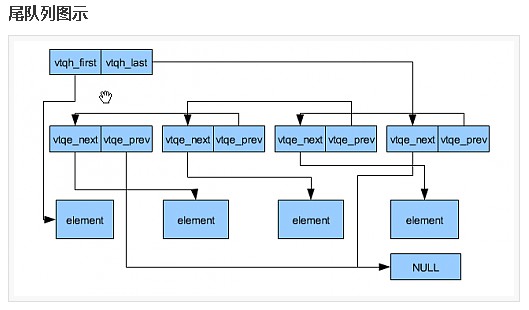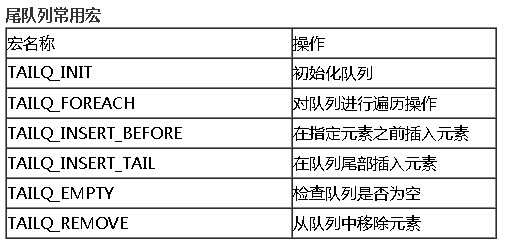queue和list的结构定义和操作都在'sys/queue.h'中完成, 主要定义了下面四种数据结构:
1单向列表(single-linked lists)
2单向尾队列(single-linked tail queue)
3列表(lists)
4尾队列(tail queues)


使用示例
复制代码 代码如下:
#include <stdio.h>
#include <stdlib.h>
#include <sys/queue.h>
/*
定义一个结构体,它只是尾队列的一个元素
它必须包含一个TAILQ_ENTRY来指向上一个和下一个元素
*/
struct tailq_entry {
int value;
TAILQ_ENTRY(tailq_entry) entries;
};
//定义队列的头部
TAILQ_HEAD(, tailq_entry) my_tailq_head;
int main(int argc, char *argv[])
{
//定义一个结构体指针
struct tailq_entry *item;
//定义另外一个指针
struct tailq_entry *tmp_item;
//初始化队列
TAILQ_INIT(&my_tailq_head);
int i;
//在队列里添加10个元素
for(i=0; i<10; i++) {
//申请内存空间
item = malloc(sizeof(*item));
if (item == NULL) {
perror("malloc failed");
exit(-1);
}
//设置值
item->value = i;
/*
将元素加到队列尾部
参数1:指向队列头的指针
参数2:要添加的元素
参数3:结构体的变量名
*/
TAILQ_INSERT_TAIL(&my_tailq_head, item, entries);
}
//遍历队列
printf("Forward traversal: ");
TAILQ_FOREACH(item, &my_tailq_head, entries) {
printf("%d ",item->value);
}
printf("n");
//添加一个新的元素
printf("Adding new item after 5: ");
TAILQ_FOREACH(item, &my_tailq_head, entries) {
if (item->value == 5) {
struct tailq_entry *new_item = malloc(sizeof(*new_item));
if (new_item == NULL) {
perror("malloc failed");
exit(EXIT_FAILURE);
}
new_item->value = 10;
//插入一个元素
TAILQ_INSERT_AFTER(&my_tailq_head, item, new_item, entries);
break;
}
}
TAILQ_FOREACH(item, &my_tailq_head, entries) {
printf("%d ", item->value);
}
printf("n");
//删除一个元素
printf("Deleting item with value 3: ");
for(item = TAILQ_FIRST(&my_tailq_head); item != NULL; item = tmp_item) {
if (item->value == 3) {
//删除一个元素
TAILQ_REMOVE(&my_tailq_head, item, entries);
//释放不需要的内存单元
free(item);
break;
}
tmp_item = TAILQ_NEXT(item, entries);
}
TAILQ_FOREACH(item, &my_tailq_head, entries) {
printf("%d ", item->value);
}
printf("n");
//清空队列
while (item = TAILQ_FIRST(&my_tailq_head)) {
TAILQ_REMOVE(&my_tailq_head, item, entries);
free(item);
}
//查看是否为空
if (!TAILQ_EMPTY(&my_tailq_head)) {
printf("tail queue is NOT empty!n");
}
return 0;
}
【c语言尾队列tailq使用示例分享】相关文章:
